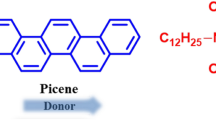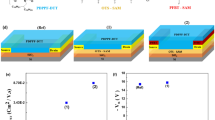Abstract
Ambipolar organic field-effect transistors (A-OFETs) allow a significant reduction in the complexity of organic integrated circuits (ICs) because they act as both n- and p-type transistors. In this paper, we report an efficient A-OFET based on the bilayer architecture of p-type poly(benzodithiophene(2-thienyl)-pyrrolopyrrole-dione) (PBDTTPPD) and n-type [6,6]-phenyl-C61-butyric acid methyl ester (PCBM). By achieving the saturation condition of the dichloromethane (DCM) solvent for preparing the PCBM solution, we successfully obtained a complete bilayer of PCBM and PBDTTPPD and used it as a carrier transport layer in an A-OFET. The A-OFET exhibits clear bipolar transport and operates as an n-type and a p-type transistor in a single device. When a positive bias is applied between the gate electrode and the source electrode, the A-OFET serves as an n-type transistor with an n-channel generated for electron transport at the interface of PCBM and PBDTTPPD. On the other hand, it serves as a p-type transistor with a p-channel generated for hole transport at the interface between PBDTTPPD and SiO2 when a negative bias is applied. The bipolar transport is modulated by morphology control using a 1,8-diiodooctane (DIO) additive and the PBDTTPPD layer thickness. The optimized A-OFET shows reasonable carrier mobilities for an ambipolar transistor with an average electron mobility of 2.22 × 10−3 cm2 V−1 s−1 and an average hole mobility of 2.29 × 10−3 cm2 V−1 s−1.
This is a preview of subscription content, access via your institution
Access options
Subscribe to this journal
Receive 12 print issues and online access
$259.00 per year
only $21.58 per issue
Buy this article
- Purchase on Springer Link
- Instant access to full article PDF
Prices may be subject to local taxes which are calculated during checkout




Similar content being viewed by others
References
Ni Z, Wang H, Dong H, Dang Y, Zhao Q, Zhang X, et al. Mesopolymer synthesis by ligand-modulated direct arylation polycondensation towards n-type and ambipolar conjugated systems. Nat Chem. 2019;11:271–7.
Yi Z, Jiang Y, Xu L, Zhong C, Yang J, Wang Q, et al. Triple acceptors in a polymeric architecture for balanced ambipolar transistors and high-gain inverters. Adv Mater. 2018;30:1801951.
Shi K, Zhang W, Gao D, Zhang S, Lin Z, Zou Y, et al. Well-balanced ambipolar conjugated polymers featuring mild glass transition temperatures toward high-performance flexible field-effect transistors. Adv Mater. 2018;30:1705286.
Lee J, Han aR, Kim J, Kim Y, Oh JH, Yang C. Solution-processable ambipolar diketopyrrolopyrrole-selenophene polymer with unprecedentedly high hole and electron mobilities. J Am Chem Soc. 2012;134:20713–21.
Dell’Erba G, Luzio A, Natali D, Kim J, Khim D, Kim DY, et al. Organic integrated circuits for information storage based on ambipolar polymers and charge injection engineering. Appl Phys Lett. 2014;104:153303.
Lao CS, Kuang Q, Wang ZL, Park M-C, Deng Y. Polymer functionalized piezoelectric-FET as humidity/chemical nanosensors. Appl Phys Lett. 2007;90:262107.
Wang J, Wang H, Yan X, Huang H, Jin D, Shi J, et al. Heterojunction ambipolar organic transistors fabricated by a two-step vacuum-deposition process. Adv Funct Mater. 2006;16:824–30.
Shkunov M, Simms R, Heeney M, Tierney S, McCulloch I. Ambipolar field-effect transistors based on solution-processable blends of thieno[2,3-b]thiophene terthiophene polymer and methanofullerenes. Adv Mater. 2005;17:2608–12.
Sun Q-J, Peng J, Chen W-H, She X-J, Liu J, Gao X, et al. Low-power organic field-effect transistors and complementary inverter based on low-temperature processed Al2O3 dielectric. Org Electron. 2016;34:118–23.
Tang W, Huang Y, Han L, Liu R, Su Y, Guo X, et al. Recent progress in printable organic field effect transistors. J Mater Chem C. 2019;7:790–808.
Sekitani T, Zschieschang U, Klauk H, Someya T. Flexible organic transistors and circuits with extreme bending stability. Nat Mater. 2010;9:1015–22.
Yoo H, Ghittorelli M, Smits ECP, Gelinck GH, Lee H-K, Torricelli F, et al. Reconfigurable complementary logic circuits with ambipolar organic transistors. Sci Rep. 2016;6:35585.
Zaumseil J, Sirringhaus H. Electron and ambipolar transport in organic field-effect transistors. Chem Rev. 2007;107:1296–323.
Dong J, Yu P, Arabi SA, Wang J, He J, Jiang C. Enhanced mobility in organic field-effect transistors due to semiconductor/dielectric iInterface control and very thin single crystal. Nanotechnology. 2016;27:275202.
Biswas S, Yang Y, Schlepütz CM, Geva N, Headrick RL, Pindak R, et al. Spatial mapping of morphology and electronic properties of air-printed pentacene thin films. Adv Funct Mater. 2014;24:3907–16.
Sharma a, van Oost F, Kemerink M, Bobbert Pa. Dimensionality of charge transport in organic field-effect transistors. Phys Rev B. 2012;85:1–6.
Cho S, Lee J, Tong M, Seo JH, Yang C. Poly(diketopyrrolopyrrole-benzothiadiazole) with ambipolarity approaching 100% equivalency. Adv Funct Mater. 2011;21:1910–6.
Yamane K, Yanagi H, Sawamoto A, Hotta S. Ambipolar organic light emitting field effect transistors with modified asymmetric electrodes. Appl Phys Lett. 2007;90:2005–8.
Ahn N, Kwak K, Jang MS, Yoon H, Lee BY, Lee JK, et al. Trapped charge-driven degradation of perovskite solar cells. Nat Commun. 2016;7:1–9.
Noever SJ, Fischer S, Nickel B. Dual channel operation upon n-channel percolation in a pentacene-C 60 ambipolar organic thin film transistor. Adv Mater. 2013;25:2147–51.
Tamilavan V, Roh KH, Agneeswari R, Lee DY, Cho S, Jin Y, et al. Pyrrolo[3,4-c]pyrrole-1,3-dione-based large band gap polymers containing benzodithiophene derivatives for highly efficient simple structured polymer solar cells. J Polym Sci Part A. 2014;52:3564–74.
Lee J, Jung YK, Lee DY, Jang J-W, Cho S, Son S, et al. Enhanced efficiency of bilayer polymer solar cells by the solvent treatment method. Synth Met. 2015;199:408–12.
Shi JW, Wang HB, Song D, Tian HK, Geng YH, Yan DH. n-Channel, ambipolar, and p-channel organic heterojunction transistors fabricated with various film morphologies. Adv Funct Mater. 2007;17:397–400.
Tamilavan V, Liu Y, Shin I, Lee J, Jeong JH, Jung YK, et al. Effects of replacing benzodithiophene with a benzothiadiazole derivative on an efficient wide band-gap benzodithiophene-alt-pyrrolo[3,4-c]pyrrole-1,3(2H,5H)-dione copolymer. J Photochem Photobiol A. 2019;368:162–7.
Song X, Gasparini N, Nahid MM, Paleti SHK, Li C, Li W, et al. Efficient DPP donor and nonfullerene acceptor organic solar cells with high photon-to-current ratio and low energetic loss. Adv Funct Mater. 2019;29:1902441.
Zhang H, Zhang F, Sun J, Zhang M, Hu Y, Lou Z, et al. Solution-processed organic field-effect transistors with cross-linked poly(4-vinylphenol)/polyvinyl alcohol bilayer dielectrics. Appl Surf Sci. 2019;478:699–707.
Fukuda T, Sato A. Fluorene bilayer for polymer organic light-emitting diode using efficient ionization method for atomized droplet. Org Electron. 2015;26:1–7.
Xie S, Wang J, Wang R, Zhang D, Zhou H, Zhang Y, et al. Effects of processing additives in non-fullerene organic bulk heterojunction solar cells with efficiency. Chin Chem Lett. 2019;30:217–21.
Liao H-C, Ho C-C, Chang C-Y, Jao M-H, Darling SB, Su W-F. Additives for morphology control in high-efficiency organic solar cells. Mater Today. 2013;16:326–36.
Acknowledgements
This work was supported by a Research Grant of Pukyong National University (2019).
Author information
Authors and Affiliations
Corresponding authors
Ethics declarations
Conflict of interest
The authors declare that they have no conflict of interest.
Additional information
Publisher’s note Springer Nature remains neutral with regard to jurisdictional claims in published maps and institutional affiliations.
Supplementary information
Rights and permissions
About this article
Cite this article
Lee, D.Y., Tamilavan, V., Shin, I. et al. Solution-processable ambipolar organic field-effect transistors with bilayer transport channels. Polym J 52, 581–588 (2020). https://doi.org/10.1038/s41428-020-0313-1
Received:
Revised:
Accepted:
Published:
Issue Date:
DOI: https://doi.org/10.1038/s41428-020-0313-1



